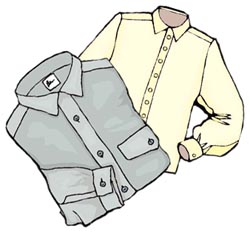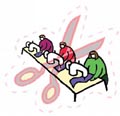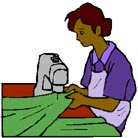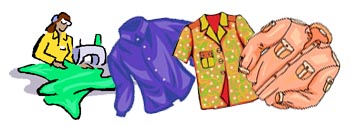2004
 Summary of the NIOSH Formaldehyde Study
Summary of the NIOSH Formaldehyde Study
Purpose:To determine if exposure to formaldehyde can cause cancer
or other diseases.
Study Design: We examined causes of death among 11,039 men and
women who had worked in one of three U.S. plants that made
shirts from formaldehyde-treated cloth.
Findings:
We found an increased risk for leukemia, especially myeloid
leukemia, among workers who:
- were first exposed in the earliest years (prior to 1963) when
formaldehyde exposures were likely higher; and
- had worked for 10 or more years in one of the three study plants.
 Conclusions:
Formaldehyde may cause leukemia at higher exposures.
However, exposures measured at these three plants since
the early 1980’s have been low, thus reducing the
risk of disease.
Conclusions:
Formaldehyde may cause leukemia at higher exposures.
However, exposures measured at these three plants since
the early 1980’s have been low, thus reducing the
risk of disease.
What is NIOSH?
NIOSH is the National Institute for Occupational Safety and Health.
NIOSH is part of the Centers for Disease Control and Prevention
(CDC). NIOSH is the Federal agency that conducts research
on the health and safety of workers.
Why did NIOSH Study the Health Risks from Exposure to Formaldehyde?
Formaldehyde is commonly used in the synthetic chemical industry, in funeral
homes and medical laboratories.
Formaldehyde has been shown to cause cancer of the nasal cavity (nose)
in rats.
Some earlier studies of workers exposed to formaldehyde had found
excess risk for various types of cancer. Other studies did
not find increased risks. Due to differences in these findings,
NIOSH conducted its own studies of formaldehyde exposure
in the workplace.
In 1985, NIOSH completed its first research study of formaldehyde.
The study examined death certificates among 256 deceased
workers from three plants which made shirts from formaldehyde
treated cloth. Formaldehyde was used at these plants to help
make shirts more crease resistant.
The 1985 study found a significantly increased risk for cancer
of the buccal cavity (cancer of the inside
of the mouth) and for multiple myeloma (cancer
of the bone marrow).
 In
1988, NIOSH completed its second study of formaldehyde exposure.
This study looked at employment records from 11,030 workers
who had been employed at any one of three plants. Two of
the three plants were the same as in the previous study.
In
1988, NIOSH completed its second study of formaldehyde exposure.
This study looked at employment records from 11,030 workers
who had been employed at any one of three plants. Two of
the three plants were the same as in the previous study.
As in the 1985 study, the 1988 study found a significantly
increased risk for cancer of the buccal cavity. Excess risks
were also seen for multiple myeloma and leukemia.
What is the Cancer Risk of Formaldehyde Determined by the International
Agency for Research on Cancer (IARC)?
The International Agency for Research on Cancer (IARC) is the
worldwide agency that determines whether chemicals cause
cancer.
In 2004, IARC categorized formaldehyde as a known cancer-causing
agent in humans.
Why is the New NIOSH Study on Formaldehyde Important?
The most recent NIOSH study is one of the largest studies ever
conducted of formaldehyde-exposed men and women workers.
The NIOSH study evaluated the potential health effects of formaldehyde
exposure over a very long period of time. The updated study
examined causes of death among workers from as early as
1955 (when formaldehyde-treated cloth was first used in the
plants) through 1998.
Who was included in the NIOSH Update Study?
9,024 women and 2,015 men who worked for three months or longer
in any one of 3 clothing plants using formaldehyde.
2,650 (24%) of the workers had worked for 10 years or longer at
the plants.
These were the same workers NIOSH studied earlier in the 1988
study.
 How Did NIOSH Do the Study?
How Did NIOSH Do the Study?
NIOSH examined the causes of death among all the workers in the
study. 2,206 (20%) workers had died from 1955 through 1998.
NIOSH collected formaldehyde exposure levels from 549 randomly
selected employees who worked in five different departments
within the three plants during the early 1980’s.
These were the “cutting,” “collar,” “parts,” “assembly,” and “packaging” departments.
NIOSH reviewed plant records and coded dates of employment,
age, gender, and race of the workers.
NIOSH compared the number of deaths from each cause among the workers
to the number of expected deaths in the U.S. general population
of similar age, gender, and race.
NIOSH also analyzed all causes of death reported for each death,
not just the main (underlying) cause. This is important for
diseases that may be present at death but are not the main
cause.
What Were the Study Results?
The death rates from all causes combined and
for all
cancers combined among
the 11,039 workers in the updated study were lower than expected,
based on the U.S. population rates.
There were no deaths from cancers of the nasopharynx (nose).
The death rate for cancer of the buccal cavity (inside
of the mouth) was only slightly elevated.
 The overall risk for myeloid leukemia was almost
1½ times what was expected.
The overall risk for myeloid leukemia was almost
1½ times what was expected.
For workers who were employed at the plants for 10 or more years
and were first exposed 20 years earlier, the risk for myeloid
leukemia was increased over
2 times what was expected.
The increase in myeloid leukemia was also seen
among those workers who were first exposed prior to 1963,
when formaldehyde exposures were likely higher.
The overall average concentration of formaldehyde measured by
NIOSH at the three plants during the early 1980's was 0.15
parts per million (ppm). This was below the permissible level
at that time, which was 3.0 ppm over an 8-hour work day.
Exposures were similar across departments and plants. In
1987 the permissible level of formaldehyde exposure was reduced
to 1.0 ppm and in 1992 was further reduced to 0.75 ppm.
What Do These Results Mean to You?
These results suggest that persons exposed to higher levels of
formaldehyde over a longer period of time may be at an increased
risk for myeloid leukemia.
The results described here are for workers as a group. The risk
for any individual cannot be predicted. This is especially
true since other individual factors may affect your risk.
Symptoms of Leukemia
Symptoms of leukemia may include: not feeling well, being tired, weight
loss, night sweats, bone pain, bleeding or bruising easily,
frequent infections, fever, and swollen glands.
Having any of these symptoms does not necessarily mean you have
a serious illness. Other less serious conditions also have
these symptoms.
To be sure, see your doctor to have your health checked, especially
if the symptoms do not go away.
Other Health Effects
When formaldehyde is present in the air at levels exceeding 0.1
parts per million, some individuals may experience minor
health effects such as watery eyes, burning sensations of
the eyes, nose, and throat, coughing, wheezing, nausea, and
skin irritation. Some people are sensitive to formaldehyde.
But other individuals may have no reaction to the same level
of exposure.
 Steps to Protect Your Health
Steps to Protect Your Health
Exposure to formaldehyde occurs when the gas is breathed in or when
the liquid gets on the skin. Keep your exposure as low as
possible. Handle formaldehyde as a hazardous substance.
Questions or Comments?
If you have any questions or comments, would like more information,
or would like a copy of the study reports:
Call our NIOSH toll-free number:
1-800-356-4674 between 9:00 a.m. and 4:00 p.m., Eastern Time, Monday through
Friday.
Say you are calling about the Formaldehyde Notification regarding
Garment Industry Workers.
Call Frank Stern directly at 1-513-841-4519.
Email questions, comments, or suggestions to nioshworkernotification@cdc.gov.
For Other NIOSH Publications
Address:
NIOSH Publications
4676 Columbia Parkway
Cincinnati, OH
45226-1996
Fax: (513) 533 8573
Email: pubstaft@cdc.gov
Web site: http://www.cdc.gov/niosh
